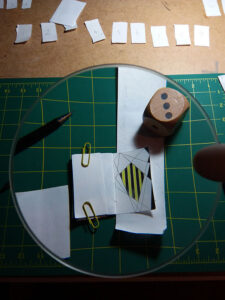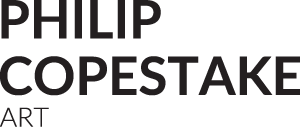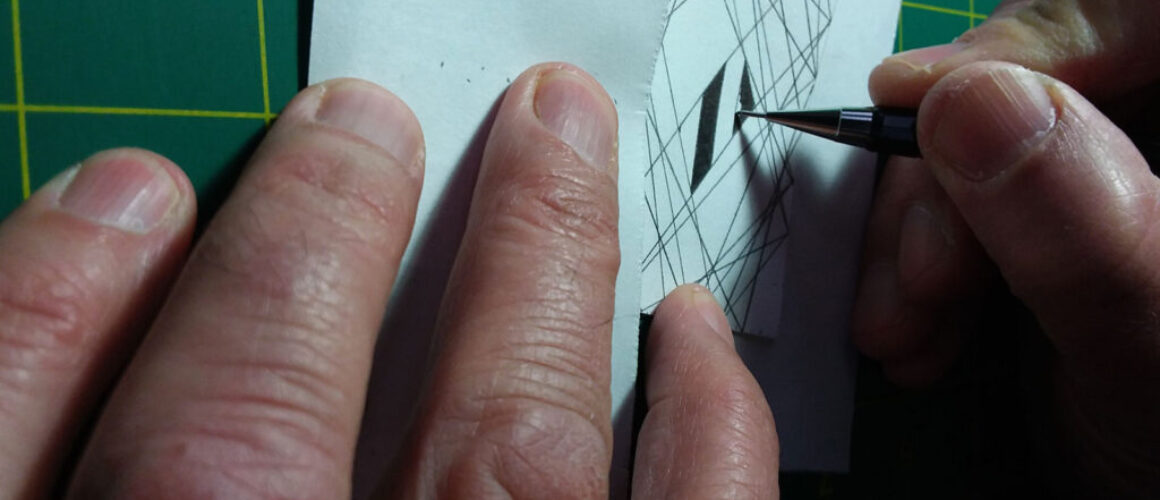Tiny Books
Here is a piece I wrote last year for artist and master bookbinder Hope Fitzgerald. I first came across Hope on Instagram when she was looking for people to join her in her Tiny Book Collaboration. This grabbed my attention, and I signed up. It is text I wrote for ‘The Page Turner’ feature in her monthly Newsletter ‘Tiny Books Tuesday’ [it comes out on a Tuesday(!) – usually the second of each month]. It’s a bit of a bio’ really, so I will just let you read on. I will write more about Tiny Books on another occasion.
* * *
‘Where to begin? ‘A line is a dot that went for a walk’ [Paul Klee]. Who knows where that line might take you. My art practice has always felt like a bit of a journey. Let’s walk…
I draw; I print; I paint; I photograph.
Of these, my work at the moment I’d say is very much focussed on drawing. I love the line and precision you can achieve with a graphite pencil or pen and ink. Drawing, for me, can be very much a meditation. A lone walk. I will often work in silence – completely absorbed. Focussed. I am also a Yoga teacher, and have always been aware of the connections between the creative process and what I do on the mat. Yoga itself can be defined as ‘the ability to direct the mind in one direction, and sustain it, without distraction.’ Draw. Breathe. It connects to something much deeper. And drawing (and many other creative processes) can also be very physical – holding still, perhaps stretched at an unusual angle; firm, but relaxed (‘sthira sukham’ in Yoga). Control.
I am also a printmaker. I like the technical aspects of printmaking – the care and precision needed. But also the unpredictability; the magic of the extraneous and unexpected marks. You never quite know how the final image will be. And every piece is unique, despite having a common ‘source’. I have worked with lino for relief printing, collagraph, love the effects you can get with etching and drypoint on metal plates, but also delight in simpler techniques such as the ink-transfer mono-printing method beloved of artist Paul Klee. There are clearly big overlaps with the more conventional drawing that I do.
And I love COLOUR, so using coloured inks, paint, or crayons in an exploratory journey on paper is always another joy. I will often mash up techniques and perhaps hand-colour or draw on prints I have done.
So, where did all this begin? Throughout my life I have been creative. I was a keen birdwatcher as a teenager, so have early drawings and (albeit not very good!) paintings of birds and other wildlife. I admired the work of the great bird illustrators such as John James Audubon, Basil Ede, and Robert Gillmore (the latter perhaps inspiring a later interest in lino-printing). But there was also clearly an interest in more figurative work. I remember doing an early drawing of Romanian gymnast Nadia Comaneci – the first to get a perfect 10.0, in the Montreal 1976 Olympics – ‘flying’ through the air. The fact that, as a fellow 14-year-old, I had a bit of a crush on her is beside the point!
I went to University in Edinburgh – not to study art, but biology, specialising in molecular biology and biochemistry. I still have my early ‘dissection drawings’ of the internal organs of rats, earthworms, frogs, miniature hydra and amoeba – in those days A-level biology practicals used real animals. I can still smell the formalin! In the microscopic world, I loved the shapes and structures (and names!) of cell organelles – mitochondria, ribosomes, endoplasmic reticulum, the Golgi apparatus, and the ‘3-D’ diagrams illustrating protein folding and their shapes of biochemistry. No surprise then, perhaps, the appeal of favourite artists such as Joan Miró and Paul Klee.
Living in Edinburgh (for five years all-in-all) really fuelled my passion for the visual arts. I felt a bit of an outsider amongst my scientific peers and would spend many hours alone when I had spare time from studying or working looking round the fabulous art galleries in the city. I loved the Scottish National Gallery of Modern Art – at the time situated in Inverleith House in the Royal Botanic Gardens; and the Fruitmarket Gallery near to Waverley Station was a particular favourite for contemporary art. The Scottish National Gallery of Modern Art – now in the wonderful Bedford Road location – remains one of my favourite galleries. I am fascinated by the process by which pictures are made. Visiting an art gallery with me can be a time-consuming business! I will often spend quite some time on a single drawing or painting, trying to see (as up close as possible) how it has been constructed.
I find it difficult to say who were, or are, my main influences, as I find inspiration in so many artists, makers and craftspeople. But, I guess, my early passion for art was driven by seeing the work of many of the 20th Century ‘greats’ – Paul Klee, Joan Miró, Henri Matisse, Marc Chagall, Wassily Kandinsky, Pablo Picasso…
So, I’d say my work is quite eclectic! Although there are certain things I am drawn to. I enjoy figurative work, and regularly attend a life drawing session in Sheffield, where I now live. I love the line and shapes of the models – and the line drawings of Matisse, Picasso, Egon Schiele, David Hockney, Lucian Freud, and Alberto Giacometti are particular favorites. I have to admit to a bit of a soft spot for Tracey Emin – I love the emotional intensity of her work, and her draughtsmanship, and am lucky enough to own one of her etchings. But her generosity and philanthropy is also inspiring. The recent setting up of her Foundation in Margate to transform the town into an artist’s haven is beautiful. What a legacy.
It was, in fact, perhaps my life drawing that really gave me the confidence to take my artistic practice seriously. I lived in London for over thirty years and would regularly attend sessions by the wonderfully creative group London Drawing, run by artist Anne Noble-Partridge. I remember doing a summer school with them in collaboration with Central Saint Martins almost as a way to ‘test’ my confidence and desire to take things further. I loved it, and not long afterwards found myself a studio in South Wimbledon near to where I lived. It was a wonderful old factory space with big windows, and it was such a fantastic privilege to be able to work in my own dedicated studio, within a community of other artists.
So, where did the inspiration for my (first) Tiny Book come from? Several years ago I started on a series of drawings, the construction and outcome of each being partly determined by the throw of a dice. The plan was (is) to produce thirty-six drawings (6 x 6), but a studio (and house) move, a global pandemic, and several other major life events put a little pause on progress. I am now back on track and well on the way. I applied the technique to my Tiny Book. After deciding on a basic ‘structure’ and set of rules, the dice would determine the direction of the line – ‘a dot going for a walk’. The book consequently evolved in an unpredictable way. Sometimes the dice would frustrate me, other times it would delight me, with the result. There is often temptation to ignore and throw again. But always I go by the dice! There is thus an element of surprise – it’s all down to chance (and generally a fair amount of graphite!). I was in quite a difficult period of my life when I decided to have a go at my Tiny Book. I had spotted Hope’s plans on Instagram and it instantly grabbed my attention. Working on my Tiny Book was a satisfying focus. Absorbing and therapeutic. I enjoyed seeing how the pages unfolded, and the ritual of seeing where the dice-throw took me. In the end it became a Book of Numbers. One to Twelve. Each page unique. Resolved and contained.

Clear to say then, I like a Project! A Process. And often have several on the go at any one time. I have a list of ideas to start. And perhaps an even longer one of projects to finish! I have drawings – yet unfinished – that I started 6 or 7 years ago. Ideas seem to come spontaneously. Possibly sparked by things I see around me. The day-to-day observations that might kindle an idea. My biggest frustration is that there just doesn’t seem to be enough hours in the day, or days in the week, to spend in the studio.
I moved to South Yorkshire at the beginning of 2019, not long before the world then went into ‘lockdown’. I have established a small studio here (although still have unpacked boxes from my move from London!). I certainly have lots to catch up on…
I am currently working on my second Tiny Book – ‘Variations on a Theme’. You can follow progress (on this and other projects) on Instagram @philipcopestakedrawing. You can also follow my other work @philipcopestakeart, @philipcopestakeprints, @philipcopestakelifeart, photo’s @philipcopestake, and the delights of our little Yorkshire garden @asmallyorkshiregarden.
Philip Copestake
May 2023’

